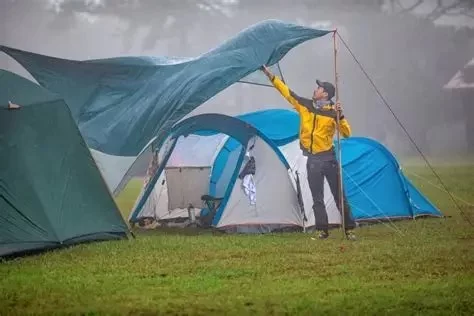- 1-understanding-severe-wind-risks-in-camping-areas
- 2-site-selection-how-to-choose-a-safer-campsite
- 3-essential-gear-for-wind-storm-preparedness
- 4-what-to-do-when-the-wind-hits-real-time-reaction-strategies
- 5-real-camper-experiences-lessons-from-the-field
- 6-safe-relaxation-recommendation-from-pine-cliff-resort
1. Understanding Severe Wind Risks in Camping Areas
Camping in the great outdoors can be serene, but nature isn’t always gentle—especially when it comes to wind storms. In many U.S. wilderness areas, sudden gusts of over 50 mph can turn a peaceful night under the stars into a dangerous situation. Understanding the risks of severe wind storms while camping is essential for both beginners and seasoned campers alike.
Strong winds can cause branches to fall, tents to collapse, and debris to fly. What makes it worse is that many campers underestimate how quickly conditions can escalate, especially in open plains or high-altitude areas. Checking weather forecasts is just the first step—preparing physically and mentally is what makes the difference.
2. Site Selection: How to Choose a Safer Campsite
2.1. Avoid Exposed Ridges and Open Fields
One of the most common mistakes is pitching a tent on a scenic ridge or open meadow. These spots may offer beautiful views but are often highly vulnerable during wind events. Opt for locations with natural windbreaks such as dense tree lines, large rock formations, or the leeward side of a hill.
2.2. Assess Overhead Hazards
Even a well-sheltered site can be risky if dead branches or unstable trees loom overhead. Before setting up, look up and evaluate the canopy. Widowmakers—branches that can fall without warning—are a real danger during wind storms.
2.3. Proximity to Emergency Exit Routes
Choosing a campsite close to marked trails or access roads can be critical if evacuation becomes necessary. Wind storms can quickly escalate into larger emergencies like forest fires or flash flooding due to broken trees or debris.
3. Essential Gear for Wind Storm Preparedness
3.1. Storm-Ready Tent Design
Use a low-profile, aerodynamic tent rated for high winds. Four-season tents are generally built sturdier and often include extra guy lines and reinforced poles. Don’t forget to stake your tent deep using heavy-duty stakes angled away from the tent at 45 degrees.
3.2. High-Visibility and Quick-Pack Equipment
In low-light, high-wind situations, visibility is key. Reflective gear, brightly colored tarps, and compact folding tools make navigating chaotic conditions easier. Keep essentials like a headlamp, emergency radio, and compact first aid kit close by and ready to grab.
3.3. Dry Bags and Waterproof Storage
Wind storms often bring sudden rain. Use dry bags to protect food, electronics, and important documents. Label and organize them so they’re easy to access even when visibility drops and panic rises.
4. What to Do When the Wind Hits: Real-Time Reaction Strategies
4.1. Reinforce and Retreat
Once you hear strong gusts or see approaching storm clouds, secure your tent by tightening guy lines and staking corners again. If winds become unmanageable, abandon the tent and take shelter in a car or natural wind barrier until it passes.
4.2. Stay Low and Minimize Exposure
During high winds, avoid standing upright in open areas. Crouch low to the ground and seek cover. If shelter isn’t available, lie flat in a depression or behind large rocks. Keep your group together and maintain verbal contact when possible.
4.3. Communicate and Assess Continuously
Use hand signals or short verbal cues if noise from the storm drowns out communication. Monitor the situation every few minutes—assess damage, injuries, or shifting weather patterns. Knowing when to stay and when to move is crucial.
5. Real Camper Experiences: Lessons from the Field
In the summer of 2023, a group of hikers near the Sawtooth Mountains experienced a sudden wind storm that downed multiple trees around their campsite. They had just 10 minutes to act. “We saw the trees swaying hard and ran to a lower trail,” one camper shared. “Our gear was wrecked, but we were safe. Planning escape paths saved us.”
Real-world stories like this highlight that wind storms during camping aren’t just inconvenient—they can be life-threatening. The key takeaway? Always be ready to act fast, and never assume fair weather will last.
6. Safe Relaxation: Recommendation from Pine Cliff Resort
If you’re looking to enjoy the wilderness without the stress of unexpected storms, consider destinations that blend nature with structure. Pine Cliff Resort offers scenic, secure locations with built-in safety infrastructure, reliable forecasts, and on-site staff who know how to handle unexpected weather events. It’s a great option for those who want peace of mind with their pine-scented morning coffee.
For families, solo travelers, or new campers, Pine Cliff Resort’s environment provides the perfect balance between nature immersion and smart planning—especially during stormy seasons. Being prepared doesn’t mean sacrificing joy; it means enhancing your camping experience with confidence.







